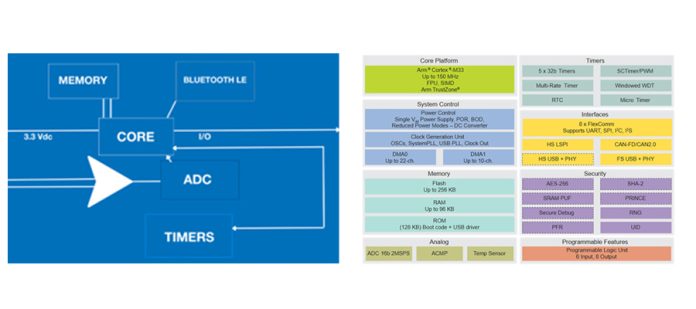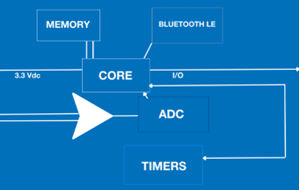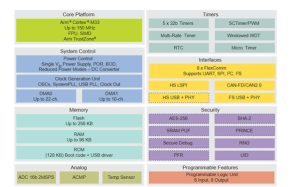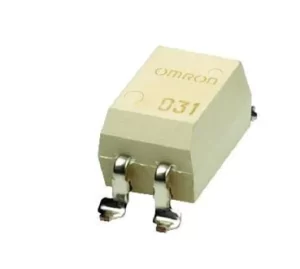Processors, Power Conversion, Peripherals
Users keep expecting more from their battery-operated and portable devices, and design engineers keep giving them more. And if engineers can make an instrument or consumer device portable, they are pushed to do so. Improved Li-ion batteries have made many portable devices practical. Wi-Fi and Bluetooth technologies are replacing wires in industrial automation systems, and wireless communication is much more prevalent now in consumer and medical devices. Industrial control systems and Internet of Things (IoT) devices need to be smaller, lighter, and sometimes portable. Even if not portable, they really need to be low power. This article looks at how engineers can examine their overall designs—including components such as microcontrollers, sensors, and actuators—to minimize power consumption.
Microcontrollers
While programming an 8-bit microcontroller (MCU) is often easier than programming a 32-bit MCU, clever hardware and accompanying software can make the 32-bit design just as low power but with the capabilities necessary in many current applications and emerging applications. The wider bus tends to use more energy, but it performs more work per cycle and can often be powered down when not in use. An 8-bit architecture, though popular, typically hits its limits when dealing with any networking or communications.
The power draw of MCUs is not always easy to determine, as it depends on many variables, including clock speed, peripheral usage, supply voltage, and memory activity. Additionally, temperature can affect power performance, increasing supply current for an ultra-low-power (ULP) MCU by a factor of ten at 80°C compared to that at room temperature. Software can make a big difference in energy consumption, so engineers should look to manufacturers who can advise in this area.
There are, perhaps, three mainstay processors at the heart of very-low-power 32-bit MCUs: Arm Cortex-M0, Arm Cortex-M4, and RISC-V. The following examples incorporate these popular processors.
Microcontroller Examples
The low-cost STM32C011 MCU from STMicroelectronics uses the 32-bit Arm Cortex -M0+ core and features direct memory access (DMA), four 16-bit timers with motor control, two USARTs, a real time clock (RTC), a fast 12-bit analog-to-digital converter (ADC), and cyclic redundancy check (CRC). Using 3.0V, the STM32C011 consumes 3800µA in run mode at 48MHz, 80µA in stop mode, 8.0µA in standby, and only 0.02µA in shutdown. The IC has up to 32kB of flash memory and 6kB or 12kB of SRAM, with nested vector interrupt control.
Texas Instruments offers an entire family of low-power SimpleLink wireless MCUs. The 2.4GHz CC2651R3 device has a 48MHz Arm Cortex-M4 processor with support for Bluetooth Low Energy, Zigbee, and the 802.15.4 low-data-rate WPAN. It includes 352kB of flash, 32kB of ultra-low-leakage SRAM, and 8kB of cache SRAM. The MCU needs 2.9mA in active mode (running CoreMark®), 61μA/MHz running CoreMark, 0.8μA in standby mode with RTC and 32kB of RAM, and 0.1μA in shutdown mode. The chip’s radio consumes 6.4mA in Rx, -7.1mA Tx at 0dBm, and 9.5mA Tx at +5 dBm. The IC has an AES 128-bit cryptographic accelerator, a true random number generator, an eight-channel 12-bit ADC, and a temperature and battery monitor.
The Analog Devices MAX32670 ultra-low-power microcontroller uses an Arm Cortex-M4 CPU with a floating-point unit (FPU). It targets industrial and IoT applications with complex sensor processing capabilities, plus AES and CRC hardware acceleration engines. The chip has a low-dropout (LDO) regulator for the 1.5V core and runs from a single 1.7V to 3.6V supply. It requires 5.0mA when active at 100MHz and only 2.6μA for full memory retention power in backup mode at 1.8 VDD. The chip has up to 384kB of flash and 160kB of SRAM and features error correction coding (ECC) over its entire RAM space. It provides two low-power timers to enable pulse counting and PWM generation even in the lowest-power sleep modes, plus I2C, 50MHz SPIs, and UARTs.
The Infineon Technologies CY8C4247LQQ-BL483 32-bit PSoC 4 MCU has a 24MHz Arm Cortex-M0 core with 2.4GHz Bluetooth Low Energy; a 12-bit, 1MS/s SAR ADC; CAPSENSE touch button interface; and up to 256kB of flash and 32kB of SRAM. The device can be powered from batteries with a voltage range of 1.9V to 5.5V. The supply current in active mode is 1.7mA at 3MHz flash program execution, while only 1.5μA in deep sleep mode using a watch crystal oscillator (WCO). Hibernate mode needs just 150nA with RAM retention. The chip has four programmable logic blocks, each with eight macrocells.
The Microchip Technology ATSAML21E MCU incorporates an Arm Cortex M0+ core with 48MHz clock in a TQFP-32 package. The chip features sophisticated power management technologies, like power domain gating, sleepwalking, and ultra-low power peripherals. It consumes as little as 35μA/MHz in active mode and 200nA in sleep mode. The ATSAML21E works from an operating voltage between 1.62V and 3.63V and offers five independent power domains. The IC has a single-cycle hardware multiplier, a micro-trace buffer, 16 external interrupts, one non-maskable interrupt, and a 16-channel DMAC. It also features a 12-channel event system and up to five 16-bit timer/counters. Active current with all functions in operation at 3.3V is approximately 85µa/MHz, while idle current is ~200µA at 12MHz. Standby current is as low as 1.5µA (or 50µA at 105°C). The MCU also features a backup state, powered by VBATT input, that requires only ~0.2µA.
The NXP Semiconductors LPC55S66 MCU features a 150Mhz Arm Cortex-M33 core and a second M33 co-processor (Figure 1), but it still manages to consume very little power. The M33 core is crafted in Armv8-M architecture and has advanced security features, including TrustZone, FPU, on-the-fly flash encryption/decryption, and a memory protection unit (MPU). It has 256MB of flash and 144kB of SRAM (640/320 optional), and nine flexible serial communication peripherals (USART, SPI, high-speed SPI, I2C, or I2S interface). The IC also offers integrated DSP instructions, support for secure boot, HASH, AES, RSA, UUID, DICE, dynamic encrypt and decrypt, debug authentication, and serial wire debug. Supply current with CoreMark code executed from SRAM in CPU0, CPU1 in Off mode, and flash powered down, with a 12MHz clock is 0.9mA. At 150MHz, the current is 6.2mA. With CPU0 in SLEEP mode and CPU1 in OFF mode with a 12MHz clock, VCC current is 0.7mA, and deep sleep can go as low as 0.11mA.
Figure 1: NXP LPC55S66 microcontroller block diagram, showing dual cores and all peripherals. (Source: NXP Semiconductors)
Silicon Labs EFR32BG22 Wireless Gecko Bluetooth 5.2 system-on-chip (SoC) combines ultra-low transmit and receive power (3.6mA Tx at 0dBm, 2.6mA Rx) and a security-enhanced, single-core Arm Cortex-M33 CPU that draws 27µA/MHz while active and 1.2µA in sleep mode. The device enables coin cell battery life of up to ten years and offers up to 512kB of flash and 32kB of RAM. Features include Secure Boot with Root of Trust and Secure Loader, a 12- or 16-bit ADC, DMA, dual I2C ports, and 26 general-purpose I/O pins. The operating range is 1.71V to 3.8V on a single supply.
Espressif Systems makes RF SoCs and modules with either Xtensa or RISC-V CPUs. All devices support 2.4GHz 802.11b/g/n Wi-Fi and Bluetooth 5 Low Energy. The ESP32-C3FH4 is a low-power SoC using a 160MHz RISC-V core with 400kB of SRAM (16kB for cache) and 384kB of ROM. Also on the chip are 14 programmable GPIOs, a DMA controller, an SAR ADC, and a temperature sensor. If the modem is idle and the CPU runs, the supply current is 23mA. In light-sleep mode—with VDD of 3.3V, SPI and Wi-Fi powered down, and all GPIOs in high impedance—the supply current is just 130µA.
Sensors
Almost every type of sensor has seen a significant reduction in required power in recent years. This trend toward lower power consumption plus decreasing costs have enabled designs that monitor almost anything, from machinery and health to communications systems, pets, and environment.
Sensor Examples
STMicroelectronics offers a variety of microelectromechanical system (MEMS) sensors that enable a performance jump and new features for consumer mobile, healthcare, and retail applications. The devices bring adaptive, machine-learning capabilities to edge applications that operate at extremely low power. The charge-variation (QVAR) sensing channel monitors changes in electrostatic charge to provide contact sensing. Applications include moisture and condensation sensing, human-presence detection, activity monitoring, and people counting.
ST’s MEMS portfolio includes the LPS22DF barometric pressure sensor and waterproof LPS28DFW barometric pressure sensor, which feature active supply current as low as 1.7µA and absolute pressure accuracy of 0.5hPa. The LIS2DU12 3-axis accelerometer offers a great ultra-low-power architecture with active antialiasing and consumes only 3.5µA at 100Hz.
Power Conversion
Most modern rechargeable battery-operated designs use a single lithium-ion (Li-ion) cell, while primary (non-rechargeable) designs will use a coin cell made of manganese dioxide lithium. Generally, Li-ion rechargeable batteries have a final charge voltage of 4.2V and an end of discharge of 3.0V. The 3V CR2032 coin battery has a 2.0V discharge cut-off and a 3.2V maximum charge point. Many MCUs have an internal regulator and can handle these voltages directly.
While high-efficiency power conversion is taken for granted these days, it can be challenging to achieve efficiency when the design’s current is very low. For battery-operated designs, the system must also perform at low and high battery voltages. An LDO linear regulator may be appropriate in such cases, but a regulated charge pump can be very efficient at low currents.
Example Power Converters
The Texas Instruments TPS62743 is an ultra-low-power DC-DC step-down converter with a quiescent current of only 360nA. The device uses DCS-Control™ topology and operates with a typical switching frequency of 1.2MHz, using a 2.2µH inductor and 10µF output capacitor. In power save mode, the device extends the light load efficiency to a current load range of 10µA. The input voltage range is 2.15V to 5.5V, providing a maximum current of 300mA. Once started, the device operates down to 2.0V input, allowing operation directly from a single Li-MnO2 coin cell.
The Torex Semiconductor XC9265 series step-down DC/DC converters have built-in 0.4Ω N- and P-channel switching transistors as well as short circuit protection and an under-voltage lockout. Using pulse frequency modulation (PFM), the chips have a fixed output voltage from 1.0V to 4.0V (±2.0%) in increments of 0.05V and regulate down to very low-current loads. Input voltage is from 2.0V to 6.0V, with a maximum output current of 200mA (XC9265A/C) or 50mA (XC9265B/D). The supply current is just 0.5µA.
Solid State Relays
Solid-state relays have improved to the point of being useful in ultra-low-power designs. Being able to drive an external device, such as an alarm or control valve from a small battery-operated unit, can be a big bonus.
Example Relays
The Omron G3VM201D MOSFET relay (Figure 2) requires a trigger forward input current of just 0.5mA typical (2mA maximum) at about 1.6V. The normally open, opto-isolated, SPST switch output handles up to 200mA at 200V AC/DC loads in a four-pin, surface-mount package. Dielectric strength is 5000VAC for 1s, and some models are available with current-limiting functions.
Figure 2: The Omron G3VM201D low-drive-current isolated solid state relay requires a trigger forward input current of just 0.5mA. (Source: Omron)
The Panasonic AQY4C is an AC/DC, dual-use, PhotoMOS, normally closed relay with an I/O isolation voltage of 200VRMS. The chips output is rated for 60V and 0.15A. The required input current is just 0.2mA, and the input voltage is 3V to 5V. Output on resistance is 4Ω typical. It comes in a small four-pin 3.5mm TSON package.
Conclusion
The combination of ultra-low power and wireless technology is one of the top trends of the 21st century thus far. This is true for a wealth of new battery-operated consumer and medical devices, but it is also true for other designs. For example, prioritizing low power draw in a vehicle’s instrument panel requires smaller and lighter wiring and offers energy savings. As this is true for almost any industrial control or IoT device, design engineers have an opportunity to improve many systems and products through informed component selection.
Jim Harrison, Consultant, Lincoln Technology Communications











